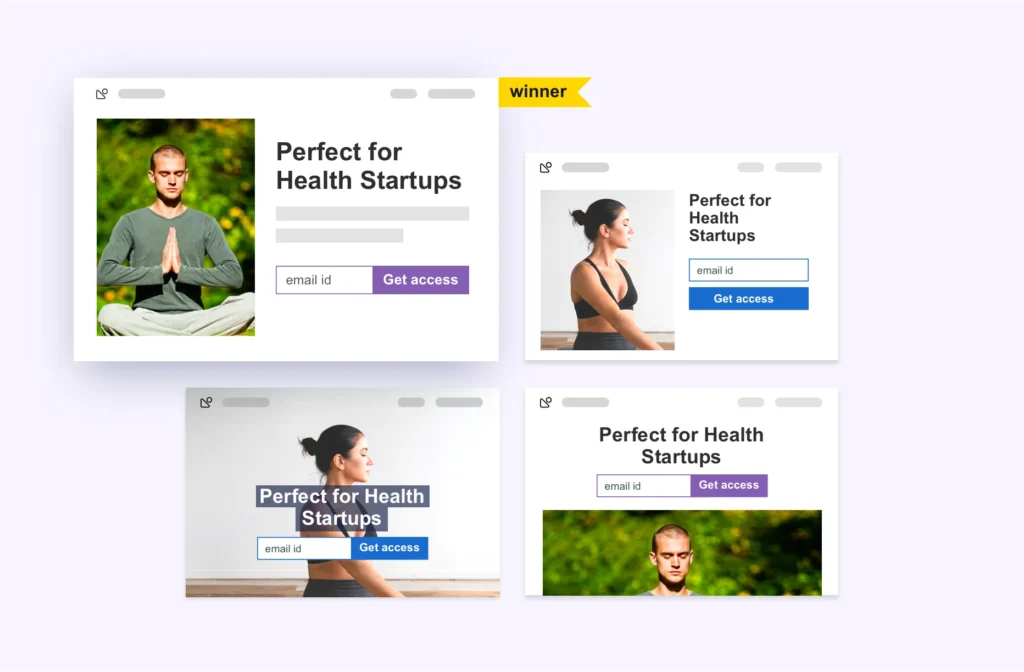A/B Testing: The Secret to Unlocking Business Success
Explore the benefits of A/B testing for improving conversion rates and optimizing your business strategy, with tips for effective testing.
KEY TAKEAWAYS
- A/B testing is a method of comparing two versions of a webpage or marketing campaign to determine which one performs better.
- A/B testing can help businesses optimize their website or marketing campaigns for maximum effectiveness.
- By using A/B testing, businesses can make data-driven decisions, which can lead to increased conversion rates, customer satisfaction, and revenue.
- A/B testing can be used for a variety of purposes, such as testing different website layouts, headlines, call-to-actions, or pricing strategies.
- A/B testing should be conducted in a controlled environment, with clear goals and metrics, and a large enough sample size to ensure accurate results.
- A/B testing is an ongoing process, and businesses should regularly analyze and optimize their results to achieve continuous improvement.
In the competitive world of business, it is essential to constantly optimize and improve your strategies to achieve success. A/B testing is a powerful tool that can help you achieve just that. By testing different variations of a website, landing page, or marketing campaign, businesses can gain valuable insights into what works best for their target audience. A/B testing can help increase conversion rates, improve user experience, and ultimately lead to increased revenue. This article will explore the benefits of A/B testing for businesses and how it can be used to optimize your conversion rate optimization (CRO) strategy. You’ll also find out best practices for A/B testing and how to analyze the data to make informed decisions. So, let’s dive into the world of A/B testing and how it can help you achieve business success.
How A/B Testing Works
A/B testing (also known as split testing) is a method of data analysis used for conversion rate optimization and to measure the effectiveness of different versions of a page or feature. Through A/B testing, companies can understand user behavior and make data-driven decisions that can improve their products and services.
Definition of A/B Testing
A/B testing is a method of comparing two versions of a web page or feature to determine which one performs better. It is a form of experiment-based data analysis where a “control” version (A) is compared against an “experimental” version (B). The two versions are presented to users at random, and the performance of each version is measured and compared. A/B testing can be used to optimize any web page or feature, such as a landing page, an email campaign, or a product page.
Examples of A/B Testing Scenarios
A/B testing can be used to measure any number of variables, such as the effectiveness of different design elements, the effectiveness of different messaging, or the effectiveness of different pricing models. For example, a company may want to test the effectiveness of different headlines on its landing page. They could create two versions of the page, one with version A of the headline and one with version B, and then measure the performance of each version to determine which one performs better.
Explanation of Statistical Significance
A/B testing relies on statistical significance to determine which version performs better. Statistical significance is a measure of how likely it is that the results of an experiment are due to chance, rather than any real difference between the versions being tested. If the results of an A/B test show that version A performs significantly better than version B, then it can be concluded that the difference between the two versions is real, and not due to chance.
Benefits of A/B Testing for Business Success
A/B testing is a data-driven method used to compare different versions of a web page or marketing asset to determine which version performs better. A/B testing is an important tool for businesses seeking to optimize their digital presence and maximize their profits. This article will discuss the key benefits of A/B testing for business success.

Photo: VWO
Improved Conversion Rates and Customer Engagement
A/B testing can be used to test different versions of a web page or marketing asset to determine which version is most effective in driving conversions. Companies can use A/B testing to optimize their digital assets to maximize their conversion rates. This can lead to improved customer engagement, as customers are more likely to convert when presented with an optimized version of the asset. A/B testing can also be used to test different versions of marketing campaigns to determine which version is most effective in driving conversions.
Increased Revenue and Profitability
By optimizing their digital assets and marketing campaigns, businesses can maximize their conversion rates, which will in turn lead to increased revenue and profitability. A/B testing can also be used to test different pricing strategies to determine which pricing strategy is most effective in driving conversions. This can help businesses optimize their pricing strategies to maximize their profits.
Reduced Risk and Better Decision-Making
A/B testing is a data-driven approach that uses data analysis to compare different versions of an asset or campaign. This data-driven approach helps businesses make better decisions and reduce the risk of failure. With A/B testing, businesses can make decisions based on data and not on intuition, which can help them reduce the risk of failure and make better decisions.
Enhanced Customer Insights and Understanding
A/B testing can also be used to gain insights into customer behavior and preferences. By testing different versions of an asset or campaign, businesses can gain insights into how customers interact with their products or services. This can help businesses understand their customers better and optimize their digital assets and marketing campaigns to improve customer engagement.
Best Practices for A/B Testing
A/B testing, also known as split testing, is a widely used data-driven approach for optimizing a website and app performance. Through A/B testing, businesses can measure the success of a product and make data-driven decisions to maximize conversions and boost business success.
A/B testing is based on the simple concept of comparing two versions of a web page or app feature to see which one performs better. To ensure successful A/B testing, businesses should follow best practices for A/B testing, such as setting clear goals and objectives, focusing on one variable at a time, conducting tests for a sufficient duration, and using reliable testing tools and platforms.
Setting Clear Goals and Objectives
Before starting an A/B test, businesses should establish clear goals and objectives to determine what they want to test and track, such as user engagement, conversions, or click-through rates. This helps ensure that the test is relevant and tailored to the specific goals of the business.
Focusing on One Variable at a Time
To ensure accurate results, businesses should focus on one variable at a time when running an A/B test. It is important to test one element at a time, such as the design, layout, or copy, to ensure that the results are not muddled.
Conducting Tests for a Sufficient Duration
For accurate results, it is important to conduct tests for a sufficient duration. This ensures that the results are representative of the actual performance of the website or app feature. A/B tests should be conducted for at least a few days, or even weeks, to measure the impact of a change.
Using Reliable Testing Tools and Platforms
To ensure accurate results, businesses should use reliable testing tools and platforms. There are a variety of A/B testing tools and platforms available, such as Optimizely, VWO, and Google Optimize, which can help businesses conduct tests with ease and accuracy.
By following best practices for A/B testing, businesses can ensure that their A/B tests are successful and accurately measure the effects of changes to their website or app. This helps to optimize the user experience, increase conversions, and ultimately boost business success. A/B testing is an essential tool for conversion rate optimization and data analysis and can be an invaluable asset for businesses looking to succeed.
Real-World Scenarios
A/B testing is a powerful tool used by businesses of all sizes to measure the success of their marketing campaigns and website changes. It can help businesses identify the most effective strategies to engage their customers and improve their conversion rate optimization. This section will explore some real-world scenarios and case studies of successful A/B testing campaigns, as well as the lessons learned and key takeaways.
Case Studies of Successful A/B Testing Campaigns
A/B testing has helped many businesses to succeed by providing valuable insights into how their customers interact with their products and services. Here are a few examples of successful A/B testing campaigns:
Case Study #1: An e-commerce company wanted to increase the number of visitors to its website. By A/B testing different web page layouts, they were able to identify a version that increased their conversion rate by 25%.
Case Study #2: A food delivery service wanted to increase the number of orders they received. They used A/B testing to compare different promotional messages and found that a particular message increased order numbers by 20%.
Case Study #3: An online retailer wanted to increase their average order value. They used A/B testing to compare different product bundles and offers and found that a particular bundle increased their average order value by 10%.
Lessons Learned and Key Takeaways
A/B testing is a powerful tool that can help businesses optimize their marketing campaigns and website changes for maximum success. Here are some key takeaways from the case studies above:
- A/B testing can help businesses identify the most effective strategies for engaging their customers.
- Data analysis is key to successful A/B testing.
- A/B testing can help businesses increase their conversion rate, number of orders, and average order value.
- Different strategies may work better for different businesses, so it’s important to test different options.
By utilizing A/B testing, businesses can gain valuable insights into how their customers interact with their products and services, and use this information to make the necessary adjustments to succeed.
Final Thoughts
A/B testing is a crucial tool for businesses looking to optimize their conversion rates and improve their bottom line. By testing different variations of their website, email campaigns, and other marketing materials, businesses can gain valuable insights into what resonates with their audience and make data-driven decisions that lead to increased conversions and revenue. The benefits of A/B testing are clear, from increased customer engagement and loyalty to improved user experience and better ROI. With the right tools and techniques, businesses can use A/B testing to continuously improve their marketing efforts and stay ahead of the competition. So if you haven’t already, it’s time to start incorporating A/B testing into your marketing strategy and see the positive impact it can have on your business success. Remember, data analysis is key to making informed decisions and achieving your conversion rate optimization goals.








































Comment Template